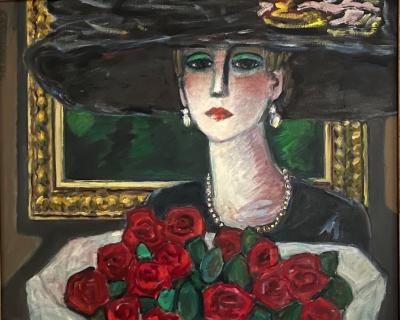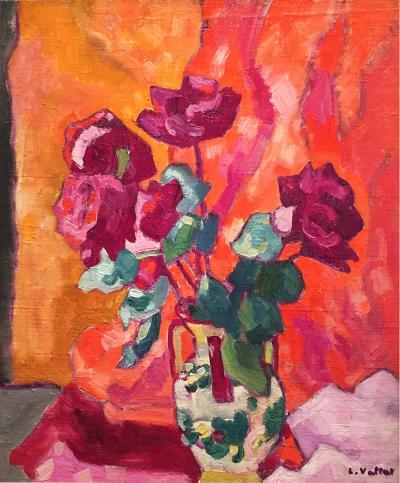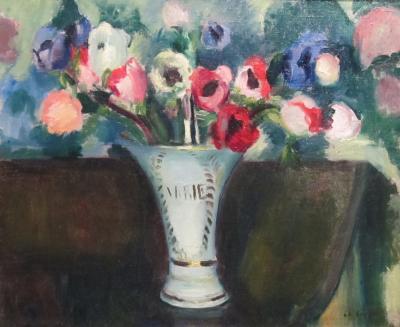Phenomena
-
Description
Paul Jenkins 1923–2012
1983
watercolor on paper
30 h × 41½ w in (76 × 105 cm)
framed: 34 x 46 inches
Signed to lower left ‘Paul Jenkins’. Signed, titled and dated to verso ‘Paul JenkinsPheno mena Uranus Conjunction 1983’.
Provenance:
GE Art Program, Fairfield, CT
Exhibited:
Between Tachisme and Abstract Expressionism: Bluhm, Francis, Jenkins, 5 October - 10 November 2017, Hollis Taggart Galleries, New York
Please note where the artist masked off the area of the canvas creating the white triangular space. Paul Jenkins was known to have utilized this technique. He is able to create a new dynamic from the interaction between the hard edge of the triangle and the soft flowing colors in the adjacent area.
Paul Jenkins was born in Kansas City, Missouri. His early interest in art was furthered at the Nelson-Atkins Museum (then the William Rockhill Nelson Gallery), where he was drawn to the Eastern collection, particularly the Buddhist frescoes and sculptures of China and India. As a teen, Jenkins worked with ceramicist James Weldon, which led to a fascination with glazes, a result Jenkins achieved in his Fifties paintings by mixing oil and enamel on canvas. For four years beginning in 1937, Jenkins attended classes at the Kansas City Art Institute where he painted his first series of watercolors he called "interior landscapes" inspired by caves in the Ozarks. After serving in the US Naval Air Corps from 1944 to 1946, Jenkins studied playwriting at Carnegie Tech in Pittsburgh and then moved to New York to study with Yasuo Kuniyoshi and Morris Kantor at the Art Students League from 1948 to 1952. During those years, Jenkins met Mark Rothko, Jackson Pollock and Barnett Newman.
In 1953 Jenkins traveled to Europe, settling in Paris which he continued to alternate with his home in New York City. While visiting museums in Paris, Jenkins was struck by the color density and luminosity in the abstract oil works termed ébauches of Gustave Moreau and the pastels of Odilon Redon. Jenkins began to experiment with poured paints in various thicknesses on canvas and paper and found this technique achieved luminosity of color which in its own way was comparable to that of Moreau and Redon. In 1954 Jenkins added Winsor Newton pigments and chrysochrome, a viscous enamel paint, into his poured paintings, further enriching their color density and incandescence. The next major development in Jenkins' technique came in 1959 when he began using an ivory knife to guide the flow of paint. That same year, he also began to title his paintings Phenomena followed by a key word or phrase. A film on Jenkins' technique titled The Ivory Knife: Paul Jenkins at Work was shown at the Museum of Modern Art and received the Golden Eagle Award at the Venice Film Festival in 1966.
In 1954 Jenkins had his first solo exhibition in Paris where he met Martha Jackson, whose New York gallery included Jenkins in a group show the following year. In 1956, Martha Jackson Gallery held a solo exhibition of Jenkins' work, from which John I.H. Baur purchased Divining Rod, 1956 for the Whitney Museum of American Art. Jenkins had another nine solo exhibitions at Martha Jackson Gallery from 1958 to 1973. Jenkins participated in Recent Drawings 1956 at the Museum of Modern Art and in Nature in Abstraction: The Relation of Abstract Painting and Sculpture to Nature in Twentieth-Century American Art in 1958 at the Whitney Museum. In the late Fifties Jenkins exhibited in museum invitationals at the Carnegie Institute, Pittsburgh, PA and the Corcoran Gallery of Art, Washington, DC. Throughout the Fifties, Jenkins was involved in both the New York and Paris art worlds, getting to know artists such as Jean Dubuffet and Mark Tobey in Paris and Willem de Kooning, Franz Kline, Ad Reinhardt, and Robert Motherwell in New York. In the spring of 1956, Jenkins visited Jackson Pollock at his studio in The Springs, East Hampton. In 1957 Jenkins exchanged his Parisian studio with Joan Mitchell's studio on St. Mark's Place in New York
Throughout the Sixties, Jenkins continued to travel throughout Europe and worked in both New York and Paris. In 1962 he participated in group exhibitions at three museums in Paris and at the Whitney Museum in New York. In 1963 Jenkins participated in group exhibitions at the Musée d'Art Moderne in Paris, the Art Institute of Chicago, and the Guggenheim Museum in New York. Also in 1963, Jenkins obtained a loft on Broadway in New York from Willem De Kooning that he used as his studio until 2000. In 1964 Jenkins traveled to Japan for an exhibition of his work at the Tokyo Gallery and worked with the Gutai in Osaka. Jenkins continued to visit and exhibit in Japan through the Eighties. Jenkins was awarded the silver medal in painting at the 30th Biennial of the Corcoran Gallery of Art in Washington, DC in 1967.
Jenkins had his first American museum retrospective in 1971 at the Houston Museum of Fine Arts and the San Francisco Museum of Art, organized by Philippe de Montebello and Gerald Nordland. In 1972 the Corcoran Gallery of Art held an exhibition Paul Jenkins: Works on Paper which traveled across the United States for the next two years. In 1973 Harry N. Abrams in New York published a monograph titled Paul Jenkins with text by the distinguished art historian Albert E. Elsen and in 1983 published Paul Jenkins, Anatomy of a Cloud.
Paul Jenkins' work can be found in many public collections throughout the United States and Europe, including the Museum of Modern Art, New York, NY; the Whitney Museum of American Art, New York, NY; the Solomon R. Guggenheim Museum; the National Gallery, Washington, DC; the Smithsonian American Art Museum, Washington, DC; the Hirshhorn Museum and Sculpture Garden, Washington, DC; and the Los Angeles County Museum of Art, California. - More Information
- Dimensions
Message from Seller:
Schillay Fine Art, Inc. Located in New York City, Schillay Fine Art continues the legacy of M. Edwin Schillay, specializing in 19th-century British art, Impressionism, Post-Impressionism, Modern, and Post-War art. For inquiries, contact 212.861.8353 or Richard@Schillay.com.
































